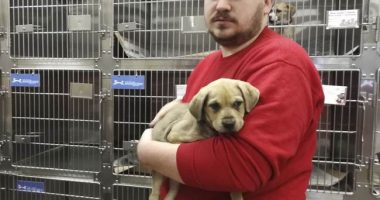It’s one of the many puzzling aspects of a case investigators will examine in the coming weeks as they try to piece together the timeline of the capsule’s movements from January 12, when it was packaged for transport, to February 1, when a recovery team found it by the side of the road.
The capsule – just 8 millimeters by 6 millimeters – was used in a density gauge fitted to a pipe at Rio Tinto’s Gudai-Darri iron ore mine to measure the flow of material through the feeder.

Rio Tinto said in a statement on Monday the capsule was packaged for transit to Perth, 1,400 kilometers, with its presence inside the package confirmed by a Geiger counter before it was transported by a third-party contractor.

“The whole team were scratching our head. We couldn’t figure out what had happened,” said Steen, whose company was not involved in its disappearance.
“If the source had been placed in a certified package and transported under all of the requirements of the code of practice, then it’s an extremely unlikely event – one-in-a-million,” she said.
How was the capsule lost?
The truck thought to be carrying the capsule arrived in Perth on January 16, four days after its departure from the Gudai-Darri iron ore mine.
But it wasn’t until January 25, when workers from SGS Australia went to unpack the gauge for inspection, that it was discovered missing.
In a statement, SGS Australia said it had been hired by Rio Tinto to package the capsule but it had nothing to do with its transportation, which was carried out by a “specialist transporter.”
“We performed the contracted service to package the equipment at the mine site and unpackage it following transportation using qualified personnel for our customer in accordance with all standards and regulations,” it said.
“The transportation of the package, organized by our client and delegated to a specialist transporter, was not within the scope of SGS services.

“Our personnel noticed the loss of the source at our Perth laboratory when opening the package and reported this incident immediately.”
The name of the company contracted to transport the package has not been released.
The missing capsule triggered a six-day search along a stretch of the Great Northern Highway.
Then on Wednesday morning, a car fitted with special equipment traveling south of the small town of Newman detected a higher radiation reading.
Handheld devices were then used to hone in on the capsule nestled in the dirt.
What are the rules for moving radioactive substances?
In Australia, each state has its own laws regarding the handling of radioactive substances and codes of practice that comply with guidelines set by the Australian Radiation and Nuclear Safety Agency (ARPANSA), a government body that works closely with the International Atomic Energy Agency (IAEA) and World Health Organization (WHO).
In Western Australia, the rules are governed by the Radiation Safety Act 1975, which Steen says is well overdue for review.

“It hasn’t been rewritten since the 70s, so I think that kind of speaks for itself,” she said.
Steen said over the decades technological advancements had made the use of radiation sources within mining equipment much safer – and because it was safer, devices were being used more frequently.
Read Related Also: Trump's lawyer admits ex-president was 'shocked' to be indicted on '30 counts of fraud'
Under the Radiation Safety Act 1975, only specially trained and licensed operators can package radioactive substances, but different rules apply to contractors hired to transport it, Steen said.
“Any transport company can transport radioactive material provided they have got the license to do so,” she said.
Under the act that license can be obtained by attending a one-day course and passing a test certified and approved by the regulator.

The licensee must have oversight of a transportation plan submitted to the regulator but does not have to supervise the journey in person. There are no rules about the type of vehicles used for transport.
Steen says clearly something went wrong – and she hopes the results of the investigation will be shared with the radiation community so they can avoid such issues in future.
Discussion has already started about the need for tougher penalties – in WA, mishandling radioactive substances carries a fine of just $1,000 – a figure described as “ridiculously low” by Australian Prime Minister Anthony Albanese to reporters on Wednesday.
Did missing bolts allow it to escape?
The rules around packaging radiation sources depend on how much radiation they emit. In some cases, the device could be encased in three layers.
In the case of the capsule, the gauge could be considered one layer of protection before it was placed into an “overpack,” a container that was likely bolted shut.
In a statement, DFES said when the package was opened the gauge was found to be broken, with one of the four mounting bolts missing.
Referring to the capsule, the statement added, “the source itself and all screws on the gauge were also missing.”
One theory investigators may examine is if the gauge broke and the capsule fell out of the overpack through a hole used to secure the lid.
It’s expected to be several weeks before the Radiological Council submits its report to the WA health minister.

Meanwhile, Rio Tinto is carrying out its own investigation.
CEO Simon Trott said the company would be willing to reimburse the government for costs associated with the search – if requested.
WA Emergency Services Minister Stephen Dawson said the offer was appreciated but the government would wait for the outcome of the investigation to apportion blame.
He said he didn’t know how much the search had cost but at least 100 people were involved including police, firefighters, health department and defence force personnel.
Staff from the National Emergency Management Agency, the Australian Nuclear and Science Technology Organization and the Australian Radiation Protection and Nuclear Safety Agency also took part.
On Thursday, relieved DFES officials released new images of the capsule being taken to Perth where it will be safely held in a facility.

Castaway rescued after four years hiding from sea lions, rats and Spaniards
This time, it traveled in a convoy of enclosed white vehicles – with big stickers warning of the presence of a radioactive substance.








